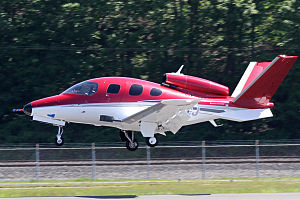Cirrus Vision
| Vision SF50 | |
|---|---|
 |
|
| Role | Very light jet |
| Manufacturer | Cirrus Aircraft |
| First flight | First prototype: 3 July 2008 Conforming prototype: 24 March 2014 First production: 5 May 2016 |
| Status | In production |
| Produced | December 2016–present |
| Number built | 9, including prototypes |
| Unit cost |
US$1.96 million (2016)
|
The Cirrus Vision SF50, also called the "Vision Jet", is a single-engine, low-wing, seven-seat, very light jet aircraft designed and produced by Cirrus Aircraft. It is the first civilian single-engine jet to achieve certification with the FAA. This makes it the smallest and least expensive certified jet currently on the market. It is also equipped with the company's CAPS parachute (which deploys from the nose of the aircraft), making it the first jet of any kind to come with a whole-aircraft ballistic parachute.
The aircraft was initially developed under the project name "The Jet", but Cirrus announced the marketing name of "Vision SJ50" on 9 July 2008. In March 2009, the aircraft was redesignated the "Vision SF50". Since its market introduction in 2016, it is often referred to simply as the "Vision Jet".
The prototype aircraft was first shown publicly at the annual Cirrus Migration on 26 June 2008 and first flown on 3 July 2008. The SF50 is intended to be a step-up aircraft for pilots who have flown the Cirrus SR20, SR22 and other high-performance light aircraft.
The aircraft was Federal Aviation Administration type-certified on 28 October 2016, after a ten-year development process, marked by aircraft technical and company financial challenges.
The Vision SF50 is made entirely of composite material (another first in the production jet industry) and is a low-wing cantilever monoplane powered by a single Williams FJ33 turbofan mounted above the rear fuselage. It has a v-tail and a retractable tricycle landing gear. The enclosed cabin is 5.1 ft (1.56 m) wide and is 4.1 ft (1.24 m) high with room for seven. Access to the cabin is through a clamshell door on the left hand side. The SF50 is designed for 12,000 flight hours.
Cirrus began taking US$100,000 deposits for the aircraft in 2006. Initially, as a public relations exercise, the company gave deposit holders a drawing of the aircraft in the form of a jigsaw puzzle, one piece at a time. In December 2006, Cirrus announced that its product will be the "slowest, lowest, and cheapest jet available." The SF50 will be powered by a single Williams FJ33-4A-19 engine, producing 1,900 pounds-force (8,500 N) of thrust and is expected to cruise at about 300 knots (560 km/h). The SF50 will seat seven people, with the cockpit, second row and the third row each seating two. There will be a seat that can slide between the second and third row or be removed entirely. The parachute will be located in the nose.
...
Wikipedia
